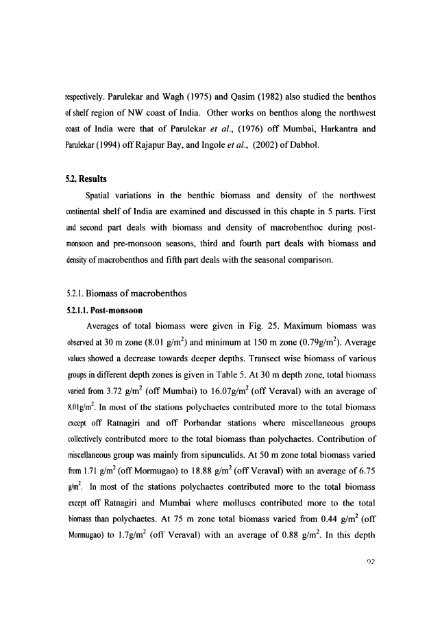L - Cochin University of Science and Technology
L - Cochin University of Science and Technology
L - Cochin University of Science and Technology
Create successful ePaper yourself
Turn your PDF publications into a flip-book with our unique Google optimized e-Paper software.
espectively. Parulekar <strong>and</strong> Wagh (1975) <strong>and</strong> Qasim (1982) also studied the benthos<br />
<strong>of</strong> shelf region <strong>of</strong> NW coast <strong>of</strong> India. Other works on benthos along the northwest<br />
coast <strong>of</strong> India were that <strong>of</strong> Parulekar et al., (1976) <strong>of</strong>f Mumbai, Harkantra <strong>and</strong><br />
Parulekar (1994) <strong>of</strong>f Rajapur Bay, <strong>and</strong> Ingole et al., (2002) <strong>of</strong> Dabhol.<br />
5.2. Results<br />
Spatial variations in the benthic biomass <strong>and</strong> density <strong>of</strong> the northwest<br />
continental shelf <strong>of</strong> India are examined <strong>and</strong> discussed in this chapte in 5 parts. First<br />
<strong>and</strong> second part deals with biomass <strong>and</strong> density <strong>of</strong> macrobenthoc during post<br />
monsoon <strong>and</strong> pre-monsoon seasons, third <strong>and</strong> fourth part deals with biomass <strong>and</strong><br />
density <strong>of</strong> macro be nth os <strong>and</strong> fifth part deals with the seasonal comparison.<br />
S.2.1. Biomass <strong>of</strong> macrobenthos<br />
5.2.1.1. Post-monsoon<br />
Averages <strong>of</strong> total biomass were given in Fig. 25. Maximum biomass was<br />
observed at 30 m zone (8.01 g/m 2 ) <strong>and</strong> minimum at 150 m zone (0.79g/m2). Average<br />
values showed a decrease towards deeper depths. Transect wise biomass <strong>of</strong> various<br />
groups in different depth zones is given in Table 5. At 30 m depth zone, total hiomass<br />
varied from 3.72 g/m 2 (<strong>of</strong>f Mumbai) to 16.07g/m 2 (<strong>of</strong>f Veraval) with an average <strong>of</strong><br />
K.Olgitn 2 • In most <strong>of</strong> the stations polychaetes contributed more to the total hiomass<br />
except <strong>of</strong>T Ratnagiri <strong>and</strong> <strong>of</strong>f Porb<strong>and</strong>ar stations where miscellaneous groups<br />
collectively contributed more to the total biomass than polychaetes. Contribution <strong>of</strong><br />
miscellaneous group was mainly from sipunculids. At 50 m zone total biomass varied<br />
from 1.71 glm 2 (<strong>of</strong>fMormugao) to 18.88 g/m 2 (<strong>of</strong>fVeraval) with an average <strong>of</strong>6.75<br />
glm 2 • In most <strong>of</strong> the stations polychaetes contributed more to the total biomass<br />
except <strong>of</strong>T Ratnagiri <strong>and</strong> Mumbai where molluscs contributed more to the total<br />
biomass than polychaetes. At 75 m zone total biomass varied from 0.44 g/m 2 (<strong>of</strong>T<br />
Monnugao) to 1.7g/m 2 (<strong>of</strong>f Veraval) with an average <strong>of</strong> 0.88 glm 2 • In this depth<br />
')2

















